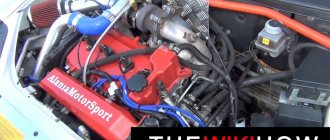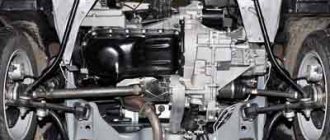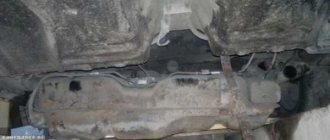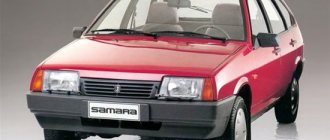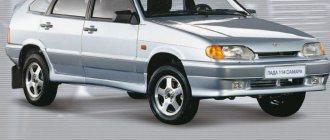Lada Kalina Station wagon "Kalinka" › Logbook › Do-it-yourself wheel alignment Lada Kalina
Good day everyone.
I decided to check the alignment myself. Why yes, because handy service technicians cannot do wheel alignment well on modern stands. I did the wheel alignment several times and no one could do it right. The first time they did it, it ate up the tires in 3000 km (the alignment was done incorrectly). Another time it started to pull towards the passenger side. I decided to check it myself. First you need to place the car on a horizontal platform. To do this, I cut 4 pieces of board (250+300 mm) for 4 wheels. I installed Kalinka on 4 boards in level (it was very difficult to search for the horizon).
Pumped up the wheels to 2 atm.
I shook the car by the rear and front bumpers. I hung the rope exactly in the center of the wheel. Prepared a plumb line. Container with oil. Calipers. A pen and a piece of paper. I took measurements. As it turned out. The wheels were tilted to one side (passenger). The top of the right wheel is tilted outward when it should be inward. The top of the left wheel is tilted inward. The camber of the equipped car should be 0 degrees 20 min +/- 30 min. This is approximately 2.0 mm. Of course, you can do it at 0 degrees. The hardest part was turning the adjusting bolts. It's inconvenient without a hole.
I didn’t do the alignment because I don’t have any tires. After the adjustment, I drove 600 km along the highway, everything became normal. I drop the steering wheel and the car drives smoothly. I'm pleased with the result. I won't go to STOshniks again. I made the alignment ruler myself. I'll check later. Good luck to everyone on the roads.
How to set the “zero” position?
It is necessary to remove the steering wheel; to do this, unscrew the nut. Afterwards, fix it in the “zero” position we calculated (the steering wheel spokes should be positioned symmetrically). Now we will be guided by this position. To test yourself, you need to alternately rotate the steering wheel left/right - it should turn the same number of revolutions in both directions, so turn the wheel to the sides as far as possible and count them.
Next, you need to loosen the tie rod end lock nuts. One rod should be unscrewed a little, and the second should be tightened by the same number of revolutions (this is very important!). This procedure can be done once and no longer change the position of the steering wheel. And in the future - just adjust the convergence.
What are the settings?
The design of the chassis and steering provides 3 main settings:
- convergence;
- camber;
- castor.
Their optimal values, that is, the wheel alignment angles on Kalina of 1-2 generations, are described in the manual for the car. An independent change “at random” will only bring harm instead of benefit. The same situation applies to other VAZ cars.
Convergence
Toe is the deviation of each wheel from the direction of travel of the vehicle. If they are directed towards each other in the direction of movement, then such convergence is called positive, but if in different directions, then negative. Turning the steering wheel changes the direction of rotation of the wheel rims by the same angle, however, due to the fact that they are initially not aligned parallel, the difference between the actual and optimal trajectories is minimal. Therefore, the toe-in of the Kalina wheels is one of the most important, but not the only parameter that affects traffic safety.
Camber
Camber is the deviation of the plane of rotation of the wheel rim from the vertical line. If the top of the wheel is tilted outward, then this is positive camber, but if it is inclined inward, then it is negative.
This parameter affects the wear rate of tires in sharp turns, as well as the stability of the car when performing sharp maneuvers. During any turn, a centrifugal force arises, which tilts the body in the direction opposite to the direction of the turn, due to which the inner (relative to this direction) side of the car is lifted above the ground, and the outer is pressed against the road.
Because of this, the following happens: the tires on the inside lose traction with the road due to decreased body pressure on them, and on the outside due to the fact that their projector is no longer parallel to the road, albeit slightly, but deviating from it. Camber changes the angle of the wheel's rotation plane to increase the tire's grip on the road during high-speed turns. A slight loss of traction during straight-line movement does not affect anything.
Castor
This is the trajectory of the suspension when driving over an obstacle. If the lower part of the suspension (steering knuckle) is directed forward, then the castor is considered positive, if backward, then negative.
The parameter affects controllability and the return of the steering wheel to its original position after the pressure on it is removed. The more positive it is, the easier the steering wheel returns to its original position, but the more difficult it is for the car to make a sharp turn. This is due to the fact that the castor changes the direction of rotation of the wheels, which is why at high values they lean slightly to the side, which worsens the contact of the tires with the road surface.
Sign 3: The steering wheel is uneven
If, when driving in a straight line, the steering wheel is uneven - tilted to the right or left, this is a reason to check the position of the wheels. An incorrect steering wheel position may be due to misalignment of the wheels on the rear axle when only the front axle was adjusted. Another possible reason is a large difference in the camber of the rear wheels: for example, when one has negative camber and the other has positive camber.
Other possible causes of the problem:
increased play in the steering mechanism;
difference in pressure between front and rear wheels;
malfunctions in the chassis;
What to do: Check the steering wheel play, chassis, tires and tire pressure. If everything is in order, inspect the tires. adjust the wheel alignment.
Instructions for adjusting wheel alignment yourself
Before you begin adjusting the camber and toe angles, it is imperative to check the vehicle's chassis. If repairs are needed, then doing a wheel alignment is pointless. The steering and suspension must be in perfect order.
Pay attention to three points on which the wheel alignment angles on a car greatly depend:
- Serviceability of the chassis (more information about car suspension diagnostics);
- Tire pressure;
- Loading the machine.
Be sure to check the tire pressure before adjusting the wheel alignment and make sure that you haven’t accidentally forgotten a couple of bags of potatoes or cement in the trunk
